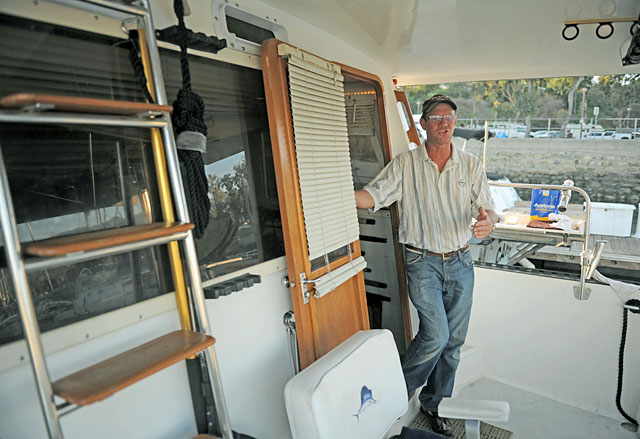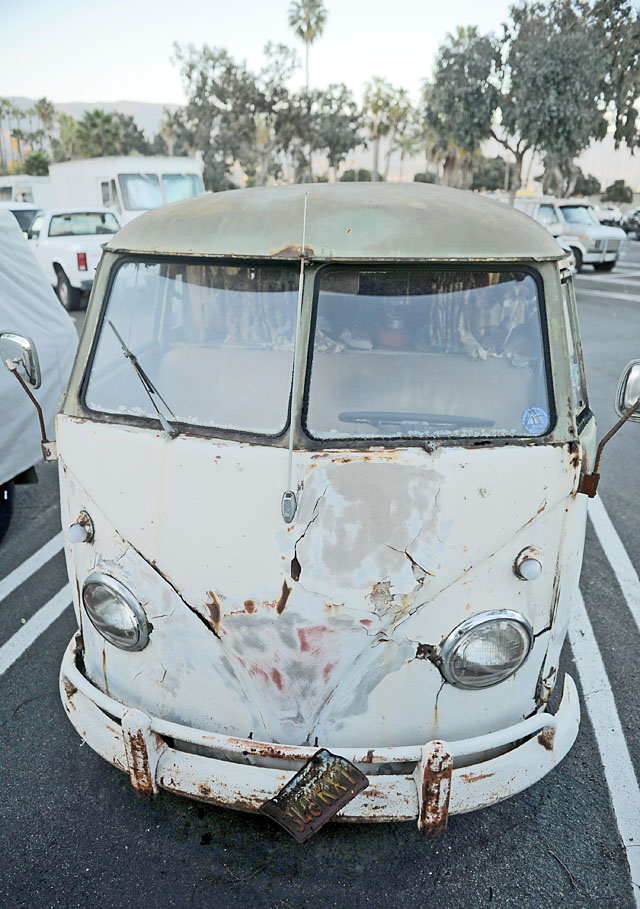Fix for Harbor Parking Woes?
Hope and Hate for Proposed Changes to Waterfront Parking Rules

With rust crusting the outside, parking permits fading on the windshield, and yellowed stacks of newspapers from the 1980s easily visible through the back window, the gray-green Volkswagen bus decomposing down in the Santa Barbara Harbor’s main lot has surely seen its share of good times, and most of them were likely within a few feet of where it sits today.
“We believe this vehicle has been staying in this lot for 27 years,” said Scott Riedman on Monday morning while showing off the various parking problems that have been “bugging him” for many of his dozen-plus years with the City of Santa Barbara’s Waterfront Administration, where he became harbormaster in November 2011. Around the lot are another 15 white vans being used as storage — both by those who live and/or work in the harbor and by others who do not — as well as many vehicles of all shapes and sizes with the proper permits that constantly park there, including one guy from Temecula who Riedman recently realized had three cars in the lot and the covered-up vehicle right next door to the VW bus. Pulling back that cover to show an out-of-state license plate, Riedman explained, “This guy lives in Washington.”
None of these people are breaking the law, however, as the current setup — which has been in existence since 1990 — is ripe for legal abuse. Or as Riedman put it, while pointing out other large vehicles in the lot, “There’s been a loophole big enough that people can literally drive a truck through.”
In trying to close that loophole with new parking rules — a process that will be discussed during a meeting this afternoon, March 12, at 4:30 p.m. in the harbor classroom — Riedman is ruffling some of the harbor’s more important sails, with complaints coming from commercial fishermen, liveaboard residents, boat workers, and even some harbor commissioners that the proposed fixes won’t solve the problem but will put an even tighter stranglehold on the boating culture.

“They’re gonna take everybody’s rights away for a few eyesores,” said Duane Landis, who lives in the harbor and has been a commercial fishermen, charter boat captain, and yacht broker over the last 20 years. “It’s ridiculous that they will punish everybody for so few things they dislike.”
Other business owners remain hopeful that the changes will cut down on the days that the lot sells out, leaving tourists, recreational boaters, and others ready to spend money in the harbor with no place to park. “I don’t have a lot of unhappy customers, but if there are complaints about anything, it’s the parking,” said Skip Abed, owner of the Santa Barbara Sailing Center. “These people have had a really cheap way of storing their stuff and vehicles for a long time, and the harbor is just trying to tighten up on policies that are enforced everywhere else. It’s something that waterfront directors in the past haven’t wanted to address.”
Permit Problems and Plans
Right now, there are two types of permits for all the lots in the Santa Barbara waterfront, which stretch from East Beach to Leadbetter, and include the main harbor lot. There’s the $70 blue permit for slipholders, those folks ranging from fishermen to residents to weekend pleasure cruisers who rent space at the dock and can have one car per slip. That allows constant parking without the need to move a vehicle all year long, save for the once per year check to make sure it’s operational.
Then there is the $95 red/orange permit for everyone else, from volleyball players, waterfront joggers, and other regular harbor/beach users to City College students (who get free access to the westernmost lots due to a 50-year agreement related to parking that extends to 2037), residents of the nearby Mesa, and slipholders with second and third vehicles. That only allows for 72 straight hours of parking before the cars must be moved. Compared to other rates in the city that are closer to $150 a month for the same privileges, Riedman opined, “It’s the best deal in town.”
Altogether, of the 1,139 slipholders, only about 750 purchase the blue permits (many others are thought to be S.B. Yacht Club members, who have their own lot), and more than 3,500 have red permits. Since the main harbor lot has less than 800 parking spots, the combination of widespread user groups means that the lot becomes sold out on popular days and weekends. That problem is only on the rise, according to a report filed by a subcommittee of harbor commissioners that formed in January to address this parking situation, which found that sellout days have nearly tripled in the past three years, with 13 sellouts in 2010 compared to 32 in 2012.
Those sellouts — plus the other days when there’s only a few spots left in a not-quite-sold-out lot — are the crux of Riedman’s concerns, not what the lot looks like. “Aesthetics is way down the list as a second thing,” said Riedman, though the large vehicles have become an attractive nuisance drawing people who think they can sleep in their cars in the lot. “We’re not out to make it prettier.”
The proposed solution involves two fronts: one, a more rigorous enforcement of the red permit rules, which are currently best described as very lax; and two, putting a 72-hour limit on the blue permits as well, forcing those who plan to be gone for up to two weeks to notify the Harbor Patrol of their plans. Whereas the two-week parking would be granted without question, said Riedman, more than two weeks of parking would require official approval based on the “extenuating circumstances.” He urged that the move is not to create a “mother-may-I” situation for harbor residents and businesspeople, and that he’s trying to make the rules as flexible as possible, despite some pleas to be even more stringent.
“That’s all we want the vehicle to do: to move,” said Riedman. “If you’re going to the Marquesas for four months, I think you need to find somewhere else to park your car.”
Attack on Culture?
For others in the harbor, the proposed parking changes are just the latest attempt to stifle the less-than-polished culture of people who work and live on boats. Along with the steep rise of cruise ship visits, growth of tourist-serving rather than boating-related retailers, and perception that the city wants to clean up the often gritty place, some are even calling this part of the harbor’s ongoing “Disneyland-ification.”
“We’re free-spirited types of people,” said Jon Payne, a boat repairman/yacht manager/sewage waste disposer who has lived in the harbor since the mid-1990s, is raising two young children there with his wife, and puts his “blood, sweat, and tears” into the place. “We don’t really plan ahead all that well. Otherwise, I probably wouldn’t be living on a boat. I’m not a paperwork guy.”
Like Landis and others, he feels that the notification process would harm the seafaring culture, would be hardest to deal with for people like him and others who work full-time in the harbor, and wouldn’t help the sellout situation, which he feels is being overblown. “They haven’t even enforced the rules we already have,” said Payne. “Wouldn’t that be a better starting point than raising the ire of all the liveaboards? Yes, it could be run better, and it isn’t the end of the world if I lose my van. But it would sure be nice if they went for other, more obvious low-hanging fruit before I’m dinged another inconvenience and another fee.”
Riedman admits that revenue growth is a major concern for his administration, especially with $300,000 in annual fees just evaporating because the S.B. Maritime Museum rent ends this year and oil companies now use a Carpinteria pier for their employees. He also appreciates the “free-spirited” boating culture but explained that it is a lifestyle decision with certain ups and definite downs. “It’s a choice,” said Riedman, while driving out of the harbor on Monday on his way to City Hall, “and it doesn’t come with a garage.”
These issues will be discussed at length this afternoon, March 12, at 4:30 p.m., in the harbor’s classroom, upstairs from the mail center.



